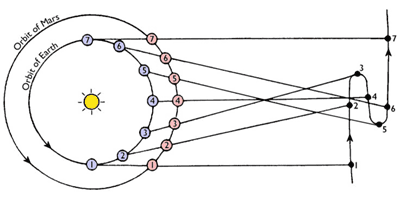In the geocentric model, Venus orbits the Earth on an epicycle, and must be always close to the Sun in the sky (this will be explained in the next post).
So what does this show? It shows that from Earth, we never see Venus "full" or its face being totally illuminated by the Sun. What we see is Venus either new or in crescent phase.
When Galileo looked at Venus, he observed that Venus also had quarter phases and gibbous phases and assumed (based on his observations), that if we could see Venus, it would be full.
Looking at the above image, we see a couple of things. When Venus is closest to the Earth, it is in what is called inferior conjunction*.
*Conjunction is a term when a planet and the Sun are in the same direction in the sky. If the planet and the Sun are in opposite directions (i.e. 180° away from each other), they are said to be in opposition. Obviously, based on Venus' location in the solar system, it can never be in oppostion.At inferior conjunction (E in the above picture), Venus is considered to be in its new phase (as seen from Earth). The unluminated portion of Venus' surface is facing Earth, much like during the new Moon, we see the darkened face of the Moon. Venus is between us and the Sun.
At superior conjuntion (A in the above picture), Venus is considered to be in full phase (as seen from Earth), if we could see Venus. As shown, the Sun is between Earth and Venus.
There are two other locations on Venus' orbit that will be discussed in the next post: greatest eastern elongation and greatest western elongation. These are the points in the orbit where Venus is the farthest east from the Sun or the farthest west from the Sun as seen from Earth. These are the "quarter" phases of Venus.
Galileo was able see Venus go through phases as he observed it just before sunrise and just after sunset. By watching how much of Venus face was illuminated and recording what he saw, he could show that Copernicus and Kepler were right. Venus did not orbit the Earth; but instead, orbited the Sun. To the same degree, if you could observe Mercury, you will be able to see Mercury go through the same phases as Venus, and also show that Mercury orbits the Sun.
























